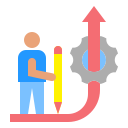Fresh Momentum: Online Platforms Revolutionizing Professional Training
Chosen theme: Online Platforms Revolutionizing Professional Training. Welcome to a hopeful, hands-on tour of how digital learning platforms are turning career growth into a flexible, data-smart, human-centric journey. Explore tools, stories, and practical moves you can apply today—then share your experiences and subscribe for future deep dives.
The Shift: How Online Platforms Are Rewiring Professional Training
From Workshops To Workflows
Online platforms weave learning into everyday workflows instead of treating it as a separate event. Short lessons surface when tasks demand them, reinforcing skills through practice. Comment with the moment you last learned something mid-task, and whether that instant access changed how confident you felt afterward.
Microlearning That Matches Real Schedules
Five-minute modules, mobile-first design, and offline downloads keep learning moving even between meetings or on commutes. Professionals report they finally finish courses because sessions are bite-sized and focused. If a micro-lesson saved your project once, share the story—others might borrow the same tactic today.
Data-Driven Feedback Loops
Completion rates are just the start; modern platforms track skill mastery, time-on-task, and application at work. Heatmaps reveal confusing topics, while adaptive difficulty adjusts the next lesson. Which metrics actually changed your team’s approach? Post your top two and why they mattered more than certificates alone.
Features That Actually Improve Outcomes
AI-guided learning routes adjust content difficulty based on performance, cutting frustration and repetition. Chat-based coaches offer nudges, clarifications, and suggested practice. When a learner gets stuck on regex or risk models, the assistant bridges the gap fast. Would your team benefit from personalized hints during crunch time?

Features That Actually Improve Outcomes
Discussion prompts, peer reviews, and cohort sprints turn solitary study into collaborative progress. Managers can join sparingly, spotlighting impact without micromanaging. Studies show social accountability doubles completion odds. Have a cohort win or fail story? Share the lesson so others can fine-tune their cadence and cadence owners.
Real Stories From The Upskilling Frontline
01
A mid-career project manager completed a platform pathway in analytics, using nightly micro-sprints after putting kids to bed. Within months, she automated report pipelines and freed ten weekly hours. Her post-course reflection attracted a mentor. If you’ve pivoted through online learning, comment with one tactic that kept momentum.
02
Clinical simulations in an online platform let a nurse practitioner rehearse triage decisions without risking patient safety. Repeated drills built calm under pressure. Later, during a real surge, muscle memory took over. Healthcare readers, which simulation features feel most authentic—and which still need better realism or feedback?
03
A five-person shop used AR modules on tablets to train technicians on machine changeovers. Downtime fell, scrap dropped, and onboarding shrank from weeks to days. The owner said the hardest part was choosing content, not tech. If you run a lean team, what one skill would AR training improve first?
Building A Learning Culture With Digital Platforms
Leadership Signals That Matter
Executives who learn publicly normalize growth. When leaders schedule learning hours, share progress, and celebrate small wins, participation climbs. Replace policy memos with example calendars and monthly reflections. Leaders, post how you guard learning time on your calendar and what reminder keeps you from canceling it.
Nudges, Rituals, And Timeboxing
Weekly learning sprints, peer check-ins, and simple OKRs keep momentum visible. Ten minutes daily beats a quarterly marathon. Platforms with reminders and streaks help, but teams need rituals too. What single ritual—Friday demo, Monday microgoal—would help your group turn intentions into visible, finished learning artifacts?
Measuring Culture, Not Just Completion
Track knowledge reuse in docs, code reviews citing course concepts, and safer experiments at work. When training shows up in decisions, culture is shifting. If you’ve changed a process thanks to a course, describe the before-and-after. Others can replicate your measurement approach next sprint.
Integration, Security, And Data Portability
Ensure single sign-on, clean HRIS and productivity tool integrations, and exportable skills data. Ask how long data persists and who owns it. Confirm compliance needs before launch. Drop a note on any integration that surprised you—good or bad—so others can avoid the same hidden snags.
Accessibility And Inclusive Design
Captioning, transcripts, screen reader support, color contrast, and keyboard navigation are non-negotiable. Inclusive examples and multilingual support widen access and outcomes. If you audit platforms for accessibility, share your favorite quick checks so the community can build equitable learning experiences from day one.
Sustainability And Maintainability Over Time
Look beyond features to content freshness, authoring tools, and governance. Who updates courses? How quickly can teams create internal modules? Sustainable platforms reduce reliance on scarce specialists. Comment with the maintenance practice that saved your library from going stale—others can adopt it this quarter.
AI-Curated Skill Graphs
Dynamic skill graphs map roles to competencies and surface gaps in real time. Employees see the shortest path to impact, not just a course catalog. If your org uses a skills framework, share a win or friction point—your insight could help someone avoid a maze of misaligned tags.
VR, AR, And Haptic Simulations
Immersive practice reduces risk in healthcare, aviation, and heavy industry, while boosting confidence and recall. Costs are falling, content libraries growing. Tried a headset-based module? Describe what felt authentic versus gimmicky, so creators can focus on scenarios that translate directly into safer, faster performance at work.
Portable, Verifiable Credentials
Open badges and verifiable credentials let professionals carry proof of skill across roles and platforms. Hiring then shifts toward demonstrated capability, not just tenure. If your team recognizes digital credentials, which standards do you trust—and how do you validate that learning truly shows up on the job?
